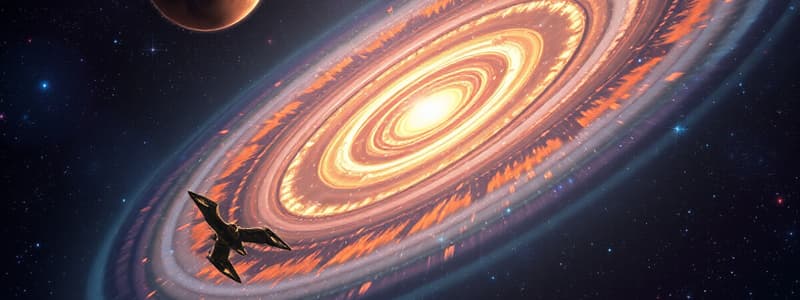Podcast
Questions and Answers
What caused the regions of matter to begin rotating during the formation of the solar system?
What caused the regions of matter to begin rotating during the formation of the solar system?
- The cooling of surrounding gases
- The collision of smaller particles
- The conservation of momentum (correct)
- The gravitational pull of the Sun
What material primarily formed the Sun during the solar system's formation?
What material primarily formed the Sun during the solar system's formation?
- Only solid matter
- Heavier metals
- Gas and dust (correct)
- Dust and ice
What is the term used for the disk that surrounded the early Sun during the solar system's formation?
What is the term used for the disk that surrounded the early Sun during the solar system's formation?
- Asteroid belt
- Spiral galaxy
- Accretion disk (correct)
- Molecular cloud
Which process describes how planets formed from the material in the protoplanetary disk?
Which process describes how planets formed from the material in the protoplanetary disk?
What happened to most of the material during the solar system's formation?
What happened to most of the material during the solar system's formation?
What is the approximate age of our Solar System?
What is the approximate age of our Solar System?
Which theory explains the orderly motions and formation of the Solar System?
Which theory explains the orderly motions and formation of the Solar System?
What caused the solar nebula to spin faster during its formation?
What caused the solar nebula to spin faster during its formation?
Which of the following processes occurs first in the formation of the Solar System?
Which of the following processes occurs first in the formation of the Solar System?
What is a significant support for the Solar Nebula Theory?
What is a significant support for the Solar Nebula Theory?
Which of the following is the largest living structure on Earth?
Which of the following is the largest living structure on Earth?
What phenomenon explains the non-uniform distribution of gravity on Earth?
What phenomenon explains the non-uniform distribution of gravity on Earth?
What was a major problem in the original Laplacian Model, which was resolved by modern theories?
What was a major problem in the original Laplacian Model, which was resolved by modern theories?
What significant observation did Edwin Hubble make in 1929 regarding galaxies?
What significant observation did Edwin Hubble make in 1929 regarding galaxies?
What is the estimated age of the universe based on current calculations?
What is the estimated age of the universe based on current calculations?
Which of the following is NOT considered a main object in the universe?
Which of the following is NOT considered a main object in the universe?
What is a characteristic of a spiral galaxy?
What is a characteristic of a spiral galaxy?
Which type of celestial body is defined as a massive, self-luminous body shining from internal energy sources?
Which type of celestial body is defined as a massive, self-luminous body shining from internal energy sources?
What distinguishes elliptical galaxies from other types of galaxies?
What distinguishes elliptical galaxies from other types of galaxies?
Which planet in the solar system is known for having the most moons?
Which planet in the solar system is known for having the most moons?
Which of the following statements about Jupiter is incorrect?
Which of the following statements about Jupiter is incorrect?
Flashcards are hidden until you start studying
Study Notes
Historical Development of Theories on the Universe
- Edwin Hubble's 1929 observation showed galaxies moving away from each other, indicating an expanding universe.
- The Big Bang Theory posits that the universe originated approximately 13.7 billion years ago from a singular event.
Key Objects in the Universe
- Stars: Massive, self-luminous celestial bodies composed of gas, shining due to internal energy sources.
- Solar Systems: Combinations of a star with planets, moons, asteroids, and other objects orbiting it.
- Galaxies: Systems of stars and interstellar matter; major types include spiral, elliptical, and irregular galaxies.
Facts About Earth
- Earth is unique as it is the only planet not named after a deity.
- It is approximately 4.6 billion years old and formed about 9 billion years after the universe began.
- Earth features recycled materials, uneven gravity, and the largest living structures, coral reefs.
Solar System Formation
- The Solar Nebula Theory combines insights from various scientists to explain solar and planetary formation.
- Gravitational collapse at the cloud's center initiated the formation of dense regions, leading to star and planet creation.
- Orderly motions of the solar system originate from a disk of gas and dust that flattened while spinning.
Nebular Collapse Process
- Increasing temperatures caused solar nebula to spin faster and flatten.
- The Sun formed at the center as surrounding material coalesced to form planets in the protoplanetary disc.
Types of Planets
- Terrestrial Planets: Comprising the four inner planets with solid surfaces.
- Gas Giants: Larger planets primarily composed of gases, devoid of solid surfaces.
Recent Discoveries
- Webb's First Deep Field image captured galaxy cluster SMACS 0723, providing insights into distant galaxies.
- Stephan’s Quintet is a compact group of galaxies located in the constellation Pegasus.
Studying That Suits You
Use AI to generate personalized quizzes and flashcards to suit your learning preferences.




